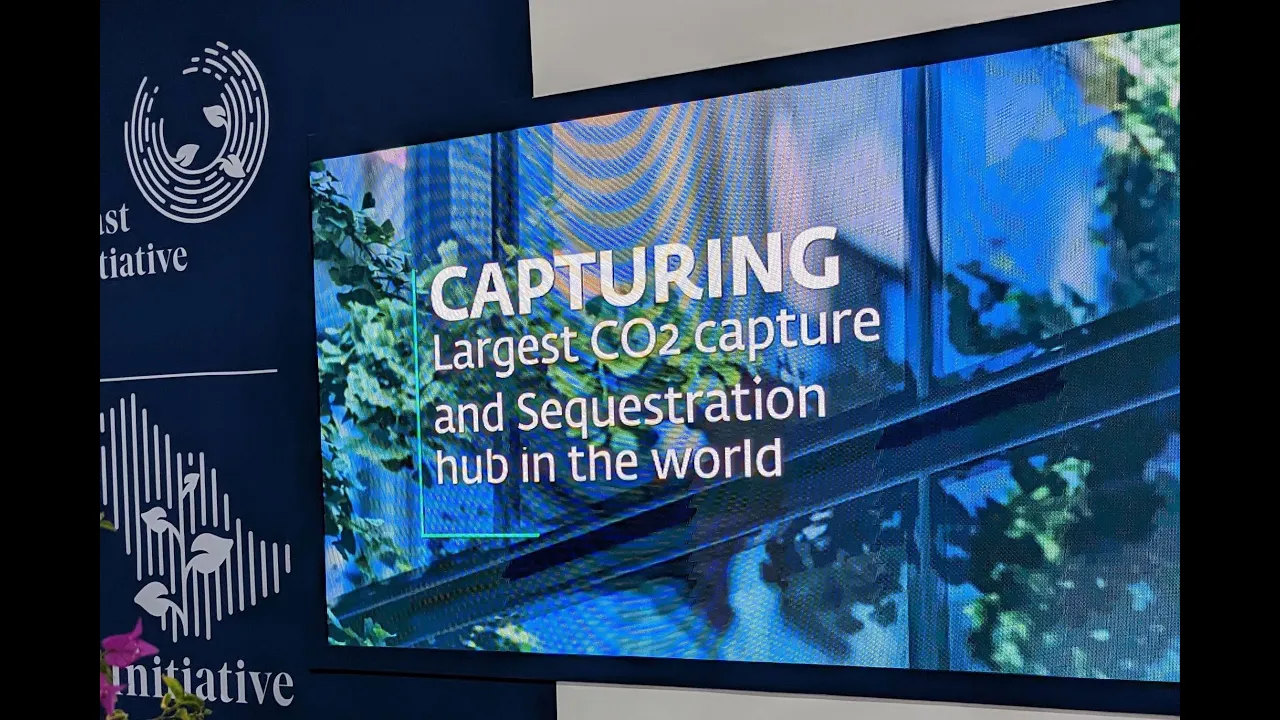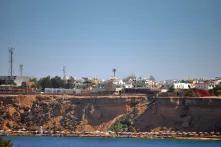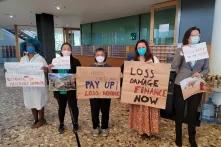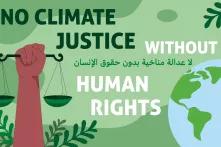The question of CO2 removals was part of the negotiations on Article 6. 4 of the Paris Climate Agreement at the UN climate conferennce COP27 in Sharm El-Sheikh. Erika Lennon of the Center for International Environmental Law (CIEL) explains what the issues and concerns were at the conference around this topic.

Hello, we are here with Erika Lennon. She is a senior attorney in the climate and energy program at the Center for International Environmental Law. Erika, you were a civil society observer at the COP 27, closely following the negotiations on Article 6.4 of the Paris Agreement. In the negotiations, the issue of carbon removals was discussed, including technological carbon dioxide removal and other technologies: Could you explain what happened in the negotiations on the Article 6.4 and what the concerns of civil society were and whether anyone else expressed concerns? And could you also explain the relevance of Article 6.4?
Erika Lennon: Sure, absolutely. So maybe I’ll start with the last question about the relevance of Article 6.4. So for those who don’t know: Article 6.4 under the Paris Agreement is basically established as the Carbon Market Mechanism under the Paris Agreement and it sets it up in some ways to essentially be the successor of the Clean Development Mechanism. This, under the Kyoto Protocol, allowed for the trading of offsets and credits and so for one country to pay for a project in another country that would generate emissions reductions credits which could be bought to offset ongoing emissions. Article 6.4 sets up, for a lack of a better word and based on the wording in the Paris Agreement, a sustainable development mechanism. In Glasgow at COP 26 in 2021, parties agreed on the package of rules for all of Article 6, which included Carbon Market Mechanisms as well as a non-market mechanism. Since than, a part of what was done was that they set up a supervisory body that was to oversee the establishment of the Article 6.4 mechanism, to have rules to the procedure, and to define what sorts of projects would take place and would be able to generate emissions reductions credits. That body met three times between July 2022 and COP 27 in November, and part of what they were mandated to do, in addition to developing rules of procedure, was to talk about recommendations on methodologies as well as on removals. That’s what they started with and they didn’t end up being able to come to an agreement on recommendations for methodologies. But they put forward a series of recommendations on removals that they had adopted and agreed to, in the middle of the night on the day that COP 27 was starting, that were submitted to the CMA, which is the body that oversees the implementation of the Paris Agreement as part of the COP. These recommendations on removals would typically then be considered by the COP or the CMA, to say “Thank you!“, to stamp them, accept them and move on. But what we saw from this supervisory body, which is comprised of 22 people, were really bad recommendations on removals. In a very broad and short decision, the definition of removals was open wide to everything under the sun, so it was land-based removals, it was engineering-based removals, it had mention of oceans. It didn’t close the door to anything, but instead opened the door to all manners of removals and geoengineering technologies, everything from direct air capture, bioenergy with carbon capture and storage, to potentially ocean fertilization. This is problematic because there really is no other definition of removals within the climate regime that we’ve seen in the Paris Agreement. And this could potentially establish what “removals” meant and provide the stamp of approval from basically the governing body for the international climate regime for these technologies and for these removals to be used to help countries meet their emissions reductions requirements. That was one concern of civil society.
Other concerns included that, also in those recommendations on removals, there were caveats in language around avoiding or addressing negative environmental and social risk from potential removal activities. There were caveats around respecting and protecting human rights for considering national circumstances. They were putting in caveats instead of having a universal adherence to human rights, which is what Glasgow Decision called for. Caveats that would allow countries that maybe didn’t want to implement them or didn’t have strict rules on human rights to disregard them. We know that a lot of projects that involve removals are likely to have severe impacts on human rights, including the rights of indigenous peoples. And so that was a major concern.
And lastly, I would say, another major concern was that this 22-member supervisory body decided on this in the middle of the night: The meetings supervisory body for the Article 6.4 mechanism have to be transparent through their webcast, and they did have provisions for the participation of observers, including a space for interacting with the observers. But in the end the supervisory body said: “We don’t have time for this, so we’re not going to be able to interact with the observers.” So there was really no participation and it wasn’t an inclusive process. And what we see, when there is not an inclusive process and no stakeholder interaction, is that they come up with these bad decisions on removals. This was what was being discussed as part of Article 6.4 at the COP and facing a lot of pushback from civil society groups, from indigenous peoples, from women, there was really sort of a cross-constituency group of people expressing concerns. Ultimately, the negotiators themselves expressed concerns about this document that was produced and about it not actually being ready for adoption. Finally, what we saw was the COP essentially thanking the supervisory body for the work they had done, but basically telling them to do it again, to go back to the drawing board, reconsider the recommendations for removals and come up with a new document over the course of this next year for adoption later.
And was the decision to refer it back to the supervisory body welcomed by civil society or were there also some concerns on that?
It’s a mixed bag: Yes, the decision to push it back for further consideration was welcomed because adopting it at COP 27 would have really been a problem. Also, when pushing back the recommendations in the decision, provisions were included for there to be submissions from observers on the recommendations for removals and that those would be considered going forward. They wanted to make sure the supervisory body was being responsive to concerns. What I would say was not welcomed was that, in one of the versions for a decision text which we saw over the course of the two weeks of the COP, there was language giving greater guidance to the supervisory body: So rather than just saying, “Come up with these recommendations on removals,” and keeping the same guidance they had before, which included needing to insure issues around permanence or avoidance and some language on negative environmental and social risk; there was nothing on guidance related to human rights or the rights of indigenous peoples. And that was in the draft text, I think, two days before the end of the COP, and also in the penultimate draft. But in the ultimate final decision all of that language on human rights was stripped out.
Civil society was really calling for both the inclusion of explicit guidance related to human rights, including the rights of indigenous peoples, as well as for the recommendations on removals to not be considered just on their own, but as part of the broader governance package. The reason for this is that it doesn’t make any sense to have recommendations on removals if you don’t also have the overall methodologies, if you don’t have in place safeguards, if you don’t have in place the rules for an independent grievance process, because all of those things are needed for the mechanism to function. Doing them in a piecemeal approach could lead to worse outcomes. These demands weren’t included. An earlier draft decision text suggested a two-year process to consider, among other things, recommendations for removals not at COP 28 at the end of 2023, but at COP 29 at the end of 2024, which we saw as better. And so not having in place this additional guidance really is a bit concerning because it’s telling the supervisory body, “Yes, you have to go back to the drawing board,” but without any additional guidance, we run the risk of them doing the exact same thing. And so I would say it was not all good or all bad on how it came out, but there’s definitely still concern.
So for the next year, we will basically have the process again on the work of the supervisory body. So what should we, as civil society, be aware of during this year until COP 28 in Dubai?
Looking ahead, the main thing to be aware of is that the supervisory body itself, I believe, has four meetings scheduled, the first one in March. Then they will meet alongside at the Intersessionals in Bonn in June. Another meeting will probably be in early fall, as well as one again just before COP 28 in Dubai. As part of those meetings, they will certainly be discussing the recommendations on removals. All of those meetings should be transparent and webcasted. They should also be open to the participation of the observers in the sense that people should be able to attend those meetings, and hopefully be in the same and not a separate room, which is what we saw at the meeting on the eve of COP 27, which was also bad for participation. Apart from the participation of civil society at the meetings, there is a call for inputs on the recommendations on removals with a deadline of March 15th. This is an opportunity for civil society to put forward in writing recommendations and submissions on how they think Article 6.4 should deal with removals. All of that should be taken into consideration by the supervisory body, who will then again, theoretically, agree to recommendations on removals as part of their work and submit that for consideration at COP 28 in the UAE.
And how is all of this linked to fossil phase-out that did not end up being in the COP 27 cover text, as well as to the language on unabated fossil fuels or unabated coal, as it is now in the decision?
One of the other disappointing developments was that in the cover decision, as you’ve mentioned, there was only a repeat of the language from Glasgow on the phase-down of unabated coal power, which obviously is one very narrow part of it, whereas civil society was calling for a phase-out of fossil fuels entirely, so coal, oil, and gas, and to remove language around unabated. One way that this is related is obviously that putting in caveats around the phase-out of fossil fuels, which is what unabated coal means, opens the door for carbon capture and storage, which is one part of what was discussed around Article 6.4. But one thing to keep in mind is that removals are not reductions, and removals by carbon capture and storage on a coal plant is not actually reducing emissions, it’s just creating a bit fewer emissions than there would be otherwise. And the other way that it’s really linked is that one of the main concerns about Article 6.4 in general, and an offset in having a carbon market, is that it allows for the continuation of businesses as usual. It allows for the continuation of fossil fuel emissions on the premise that you can continue your emissions and pay for mitigation elsewhere or, in this case, removals elsewhere, potentially, that you then use to offset your ongoing emissions. So not including that there needs to be this reduction of fossil fuels, which are the main drivers of climate change, is really missing the boat. If we have any hopes of staying below 1.5 degrees, we need to be concentrating on ending the drivers of climate change, ending reliance on fossil fuels and a phase-out of fossil fuels, full stop! Rather than trying to develop rules or creating offset markets because we’re never going to be able to offset our way to keeping global temperature rise below 1.5 degrees.
Thanks for putting this into context. And what would be the broader implications for the UNFCCC Framework and the Paris Agreement or the goals of the Paris Agreement? What would be the risks and concerns and what do we need to do?
I think there are a few broader implications and a few risks that are really highlighted by what has happened related to the discussions around Article 6.4: The first one, I would say, is really looking at the participation angle. As I mentioned, the recommendations on removals were adopted in the middle of the night, observers weren’t in the room, they ended up canceling stakeholder engagement. I think that really this is reflective of the broader concerns we saw going into COP 27 about the need for there to be respect for civic’s base and for climate negotiations themselves generally, and more broadly for all climate action to really be done through inclusive and transparent processes that include the voices of civil society, that include the voices of indigenous peoples, that include the voices of women and the youth and all of those who are most impacted. Because when you include people in decision-making, you lead to better outcomes. What we see here is a terrible outcome through an exclusive process that civil society ultimately wasn’t allowed to contribute adequately to, and that leads to really bad outcomes. I think that’s one lesson or one implication that we see from this, one that shouldn’t be replicated. Another implication is that the carbon market generally and the mechanism under 6.4 do have the risk of undermining the integrity of the Paris Agreement because, as I’ve mentioned, we’re not going to be able to offset our way to 1.5 degrees. What we really need is real reductions, not technofixes, not a focus on removals, because that’s not going to take us there. We run the risk of these removals or this mechanism distracting from what really needs to happen and providing an “out” or a caveat so that countries think that they can rely on technological fixes that don’t exist at that scale yet, that will come with a potentially huge risk to the environment and people rather than reducing emissions. This risks overshooting the goal of keeping global temperature rise below 1.5 degrees. If we overshoot that goal, we don’t know what will happen. According to the IPCC and science, there are potential harms or things that will occur which we won’t be able to come back from. Even if we are able to overshoot 1.5 degrees and come back a little bit, there are harms that will already have occurred which we won’t be able to reverse. And, I think, that is the broader implication. We shouldn’t be focussing on removals and on only phasing down unabated fossil fuels, as opposed to phasing out all fossil fuels immediately. Only after that phase-out we can enhance ambition through the market, as opposed to undermining it by merely having offsets, thus we will be able to keep temperature rise below 1.5, which is the goal and nothing should be distracting from that. These decisions, and potentially introducing geoengineering technologies or other false solutions distracts from that goal and from what we really need to do, which is to phase out fossil fuels.
Thank you very much for your analysis, your insights and your time. This has been really interesting, and we’ll be following the negotiations and the developments around that. Thanks a lot.



